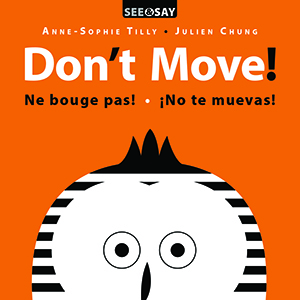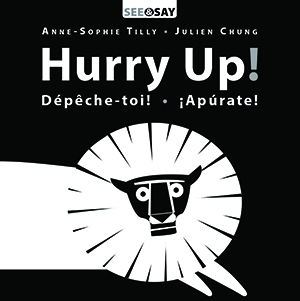| ________________
CM . . .
. Volume XXIII Number 32. . . April 28, 2017
excerpt:
As can be seen in the titles of these two board books, their contents are in English, French and Spanish. Don’t Move! = Ne bouge pas! = ¡No te muevas! begins with a question, the one in the above excerpt. On the page facing the text, just part of an animal can be seen, but turning to the next pair of facing pages reveals both the name of the animal in English, French and Spanish (monkey/singe/mono) and a cartoon-like illustration of the animal. The following pair of pages then begins the process anew, but now just the definite article is repeated, with the rest of the question being implied. In all, Tilly and Chung introduce youngsters to seven different animals: monkey, rhinoceros, chameleon, toucan, crocodile, warthog and pink flamingo. Because each of the animals has a different coloured background, this board book could also be used to teach colours. While the meaning of the book’s title initially appears unclear, the final double-page spread provides the needed clarification as owl can be seen taking a photo of the animal septet who, of course, must not move. In Hurry Up! = Dépêche-toi! = ¡Apúrate!, 14 animals are, one-by-one, seen “hurrying up”, but why? Young readers may anticipate the worst as several of the animals appear to be looking behind them as if something might be chasing them. As was the case with the previous board book, the closing double-page spread provides the answer – mouse is about to begin reading “The Jungle Book” aloud. That’s it’s “The Jungle Book: that mouse is reading explains why the buffalo shown is a Cape buffalo and not a North American bison. In this book, the text is limited to just the name of each animal, with the English word backgrounded in yellow, the French in mauve and the Spanish in green. Chung’s illustrations of the animals are most effectively rendered in just black and white, with the animals sometimes appearing against a detailed background. Tilly and Chung achieve some subtle humour by including a snail and turtle among those hurrying up. Both of these multi-lingual board books are excellent in developing youngster’s vocabulary and would be especially valuable in bilingual preschool settings. Highly Recommended. Dave Jenkinson, CM’s editor, lives in Winnipeg, MB.
To comment
on this title or this review, send mail to cm@umanitoba.ca.
Copyright © the Manitoba Library Association. Reproduction for personal
use is permitted only if this copyright notice is maintained. Any
other reproduction is prohibited without permission.
Next Review | Table of Contents For This Issue -April 28, 2017 |

